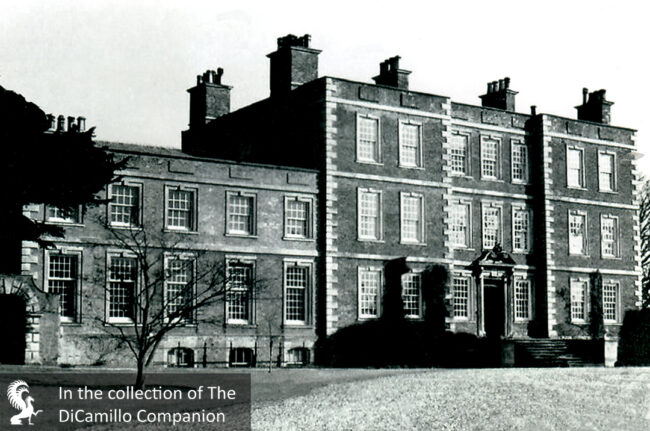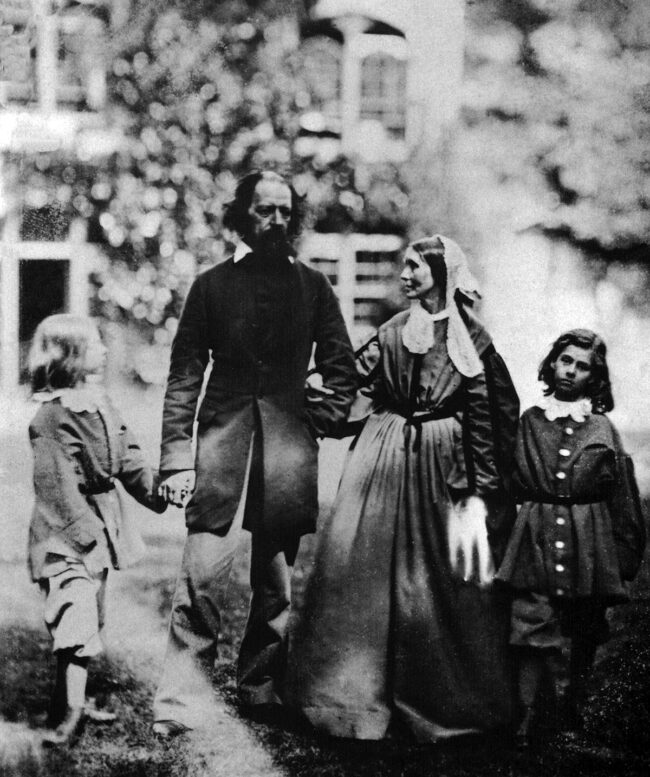
The house from a circa 1905 postcard

Alfred Tennyson, his wife Emily, and sons Hallam and Lionel from a circa 1862 photograph. Gunby is believed to be Tennyson's "haunt of ancient peace." The photo is in the collection of the Museum of Reading. This image is in the public domain.
Earlier Houses: The current house sits on the site of a small Medieval manor house that belonged to the Gunby family. There is also evidence of the Medieval village of Gunby (aka Gunnebi) and Iron Age buildings on the Gunby Estate.
Built / Designed For: Sir William Massingberd, 2nd Bt.
House & Family History: Built of a warm, plum-colored red brick (some of which was brought from Holland), Gunby is noted for its lovely paneled rooms and fine oak staircase. The house was built around 1699-1700 for Sir William Massingberd, 2nd Bt., and remained in the ownership of his descendants until 1944. The Victorian poet laureate, Alfred, Lord Tennyson, who lived nearby, very likely was describing Gunby when he wrote “…and one an English home, gray twilight pour’d On dewy pastures, dewy trees Softer than sleep—all things in order stored, A haunt of ancient peace” in his 1832 poem "The Palace of Art." Charles Langton-Massingberd, who owned Gunby in the 19th century, bequeathed the house to his eldest daughter, Emily Caroline, at his death in 1887. Emily, a passionate teetotaler and political activist, was an active campaigner for women’s rights who founded the Pioneer Club, a pro-suffrage members’ club for the education and advancement of women. In the 20th century Gunby was the seat of Field Marshal Sir Archibald Montgomery-Massingberd, who rescued the house from demolition during World War II, when the RAF planned to build a new runway on the site of Gunby Hall. His appeal to the king, George VI, saved the house, which the field marshal gave to the National Trust in 1944 as a gift to the nation in gratitude for Gunby’s survival. James Lees-Milne, who negotiated the acquisition of Gunby for the National Trust, wrote in his 1992 book, "People and Places," “…in the whole history of the National Trust, the transfer of a large estate to the Trust never happened more speedily or smoothly than Gunby” (it was one of Lees-Milne’s favorite houses). The field marshal’s wife, Lady Massingberd, had a second cousin by the name of Ralph Vaughn-Williams; the famous composer’s song "Linden Lea" was first performed in 1902 in the Victorian oak-paneled music room at Gunby. Largely formed between 1690 and 1730, Gunby’s library is considered one of the best examples of a surviving 18th century squire’s library. The house is rare in having its servants’ quarters preserved perfectly intact.
Collections: Gunby contains two exceptional portraits by Reynolds: one of Bennet Langton and the other of his wife, the Dowager Countess of Rothes. The collection also includes work by William Holman Hunt, William Morris, and Edward Lear, in addition to an important collection of furniture and porcelain.
Comments: Henry Thorold, writing in "Lincolnshire Houses," described Gunby as "...a captivating house...like a lovable big doll's house" and a house that "...seems always to have been loved and cherished, which gives it its special family atmosphere."
Garden & Outbuildings: The garden was dismantled in the 1920s and restored by the National Trust at the end of the 20th century. The Gunby Estate, which today stands at approximately 1,500 acres, includes eight acres of walled gardens that grow flowers, vegetables, and fruit, including over 50 varieties of apple trees. Gunby is supposedly haunted by the builder of the house, Sir William Massingberd, who supposedly discovered that either his wife or his daughter (take your pick) was about to run away with a servant. Sir William then lay in wait and killed the servant and threw his body in the pond. It is by the pond, today called the Ghost Walk, that the spectre most frequently appears.
Chapel & Church: Located on the Gunby Estate is the late 17th century Monksthorpe Chapel, one of the two best surviving English examples of an early Baptist chapel. Largely rebuilt in the 19th century, the chapel is owned by the National Trust and open to the public. Within the park lies St. Peter's, the Medieval parish church of Gunby that was rebuilt in the 1870s.
Country Life: XCIV, 816, 860, 1943.
Title: Lincolnshire Houses
Author: Thorold, Henry
Year Published: 1999
Reference: pgs. 55-57
Publisher: Norfolk: Michael Russell (Publishing) Ltd.
ISBN: 0859552543
Book Type: Hardback
Title: People and Places: Country House Donors and the National Trust
Author: Lees-Milne, James
Year Published: 1998
Publisher: London: John Murray (Publishers)
ISBN: 0719551455
Book Type: Hardback
House Listed: Grade I
Park Listed: Grade II
Past Seat / Home of: SEATED AT EARLIER HOUSE: Gunby family. Sir Thomas Massingberd, 15th century; Sir Henry Massingberd, 1st Bt., until 1680; Sir William Massingberd, 2nd Bt., 1680-1700. SEATED AT CURRENT HOUSE: Sir William Massingberd, 2nd Bt., 1700-19; Sir William Massingberd, 3rd Bt., 1719-23; William Meux-Massingberd, 1738-81; The Rev. Algernon Langton-Massingberd, 1835-44; "Naughty" Algernon Massingberd, 1849-52; Peregrine Langton-Massingberd, 1852-56; Charles Langton-Massingberd, 1856-87; Emily Langton-Massingberd, 1887-97; Stephen Massingberd, 1898-1925; Field Marshal Sir Archibald Montgomery-Massingberd, 1925-47; Montgomery-Massingberd family here until 1967.
Current Ownership Type: The National Trust
Primary Current Ownership Use: Visitor Attraction
House Open to Public: Yes
Phone: 01909-486-411
Fax: 01909-486-377
Email: [email protected]
Website: https://www.nationaltrust.org.uk
Historic Houses Member: No